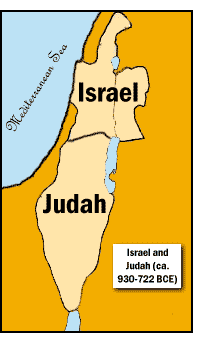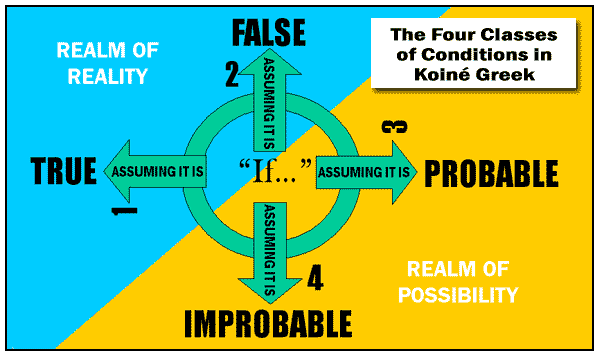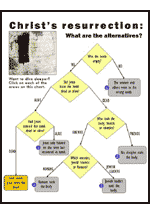

Here is issue number 4, another labor of love. Please pray for me and my wife, Cindy, because as a part of my "tent-making" job, I will be doing a lot of traveling over the next few weeks: Colorado Springs, Los Angeles, Chicago, Atlanta, and New York are my destinations. I was scheduled to go to London also, but that part of my itinerary was canceled. Hopefully, the DeeperStudy Newsletter will still go out on time, despite all of the travel. The next issue is due out on October 12.

This is too big a topic to cover in one issue. The first installment examines the terms used to discuss Judaism and the ancient nation of Israel.
Judaism, Jew, Judea, etc. – Unfortunately, many of the terms associated with Judaism are virtually indistinguishable in common usage. The terms "Judaism," "Jew," "Jewish," "Judea," and "Judeans" for example, are all based on the name of the patriarch Judah, one of the 12 sons of the patriarch Jacob (conveniently listed in Gen. 35:23-26). The story of the births of these brothers, along with Dinah, their only sister, which is an amazing account of wifely competition, is recorded in Gen. 29:16 - 30:24 and 35:16-18.

Strictly speaking, the terms "Judaism" and "Jew(s)" should not describe Israelites earlier than 721 B.C.E., the year that the Assyrians conquered the northern nation of Israel, leaving only the southern nation of Judah. From that time on, "Judah" was used synonymously with "Israel" and "Jew" with "Israelite," even for descendants belonging to tribes other than Judah. This is because by 721 B.C.E., and for almost 200 years previously, "Judah" referred not only to the tribe that descended from Judah himself, but also to the political entity composed mainly of the tribe of Judah, but also including the tribes of Benjamin, Simeon, and most of Levi, with members of other tribes included as well. In actual usage, however, "Judaism" and "Jewish nation" applies to the entire history of Israel, from its founder, the patriarch Abraham, Jacob's grandfather (c. 1800 B.C.E.). The related term, "Judaea" was the name the Romans gave to the southern portion of Palestine after they took control in 60 B.C.E.
Israel, children of Israel, Israelites, Israelis – Because God renames Jacob "Israel" (Gen. 32:28), these boys are called "the sons of Israel," and their descendants "The 12 tribes of Israel," "the children of Israel," or simply "Israelites." This should not be used interchangeably with "Israelis," which properly refers only to citizens of the modern nation of Israel.
Hebrews – A rarer term is "Hebrew," used only 34 times in the Old Testament. Two theories compete with each other regarding the origin of this name. Some say it comes from "Heber," an ancestor of Jacob's grandfather, the patriarch Abraham (Gen. 11:14-26). Abraham is called a "Hebrew" (Gen.14:13), and the name "Hebrews" is often applied to his many descendants through his son Isaac and his grandson Jacob (Gen.39:14, 17; 40:15; Exod.3:18; 1 Sam.4:6; 14:11; Phil.3:5). (The name "Hebrew," however, does not apply to Abraham's many descendants through his son Ishmael. These people the Bible calls "Ishmaelites," according to Gen.25:12-18 and are held by tradition to be the ancestors of the Arabs.) A second theory is that it comes from a similarly spelled Hebrew verb, ‘abar, which means “to cross over.” Hebrews, then, would be those who have crossed over some boundary, in other words, foreigners. The logical boundary it might refer to is the Euphrates River (see Josh. 24:15).
Habiru, Hapiru, SA.GAZ – Archaeologists have long debated whether the biblical term "Hebrew" is related to the name “Habiru” or “Hapiru” or the cuneiform name SA.GAZ. These three are found in documents of Mesopotamia, Syria, Palestine, and Egypt of the second millennium B.C.E. A useful summary of the ongoing debate occurs in LaSor, Hubbard, and Bush (207):
 The earliest mention of the SA.GAZ or Habiru occurs in a text from the Third Dynasty of Ur (ca. 2050); if the ‘pr and Habiru are the same—which is not at all firmly established—references to the Habiru can be found in Assyrian, Babylonian, Ugaritic, Egyptian, and Hittite texts for the next seven or eight hundred years.
The earliest mention of the SA.GAZ or Habiru occurs in a text from the Third Dynasty of Ur (ca. 2050); if the ‘pr and Habiru are the same—which is not at all firmly established—references to the Habiru can be found in Assyrian, Babylonian, Ugaritic, Egyptian, and Hittite texts for the next seven or eight hundred years. Identification of the Habiru with the Hebrews is tempting, and a number of scholars have adopted it. However, it is impossible to interpret most references to the Habiru as also indicating the Hebrews. Moreover, the Habiru are described as warriors, mercenaries, marauders, and caravaneers all over the ancient Near  East—which does not fit the biblical picture of the Hebrews. If the Exodus was in 1446, then at the same time the Hebrews were in the wilderness of Sinai, [the Egyptian pharaoh] Amenhotep II (1438-1412) was reporting the capture of 89,600 prisoners, among them 3,000 ‘Apiru, from his campaign in Syria and Palestine. If it [i.e., the Exodus] was in 1290, then the Hebrews were still slaves in Egypt at the time of Amenhotep. Neither case permits an easy identification.
East—which does not fit the biblical picture of the Hebrews. If the Exodus was in 1446, then at the same time the Hebrews were in the wilderness of Sinai, [the Egyptian pharaoh] Amenhotep II (1438-1412) was reporting the capture of 89,600 prisoners, among them 3,000 ‘Apiru, from his campaign in Syria and Palestine. If it [i.e., the Exodus] was in 1290, then the Hebrews were still slaves in Egypt at the time of Amenhotep. Neither case permits an easy identification.
The problem of the Habiru cannot be solved here. The important point is that identification of the Habiru with the Hebrews is not easy.
It appears that "Habiru" is either a broad term for semi-nomadic peoples, of which the Hebrews were one component, or not an ethnic term at all but a sociological one—a class of wanderers who do not consider themselves subject to local laws and who hire themselves out for caravans, mercenary armies, or as servants of one kind or another. The breadth of the occupations described by the word as well as the extensive geography involved, has led many scholars to conclude that “Habiru” came to be used rather loosely as a derogatory term for anyone in a menial capacity, or anyone who was a foreigner.
Semitic – Another broad term is "Semitic," though non-Biblical, comes from Shem, one of the three sons of Noah, many generations prior to Abraham. All of Shem's descendants can be called "Semitic," which would include both Arabs and Jews, though modern usage often limits the term to the Jews only.
Want to dive deeper? – Here are some sources you can pursue in your study of the terminology of Judaism:
Less advanced:
1982 LaSor, W. S.; Hubbard, D. A.; and Bush, F. W. Old Testament Survey: The Message, Form, and Background of the Old Testament. Grand Rapids: Eerdmans. 206-207.
1983 Yamauchi, Edwin. "Habiru," 223-224 in New International Dictionary of Biblical Archaeology. Ed. E. M. Blaiklock and R. K. Harrison. Grand Rapids: Zondervan.
More advanced:
1965 Von Rad, Gerhard, and others. Article on Israel, Israelite, Jew, Judea, Jewish, Judaize, Judaism, Hebrew, Hebraic, etc., 3:356-391 in Theological Dictionary of the New Testament. Ed. Gerhard Kittel and G. W. Bromiley. Grand Rapids: Eerdmans.
1969 Harrison, R. K. Introduction to the Old Testament, with a comprehensive review of Old Testament studies and a special supplement on the Apocrypha. Grand Rapids: Eerdmans. 318-325.
1976 Mayer, Reinhold, and others. "Israel, Jew, Hebrew, Jacob, Judah," 2:304-323 in New International Dictionary of New Testament Theology. Ed. Colin Brown, and others. Grand Rapids: Zondervan.
1980 Harris, R. L. "‘abar word group" "‘eber," and "‘ibri," 2:641-643 in Theological Wordbook of the Old Testament. Ed. R. L. Harris, G. L. Archer, Jr., and B. K. Waltke. Chicago: Moody.
1981 Bright, John. A History of Israel. 3d ed. Philadelphia: Westminster.93-96, 134-143.
Online resources:
Links for studies on Habiru/Hapiru/‘Apiru
In English, when you say "If," the best way to tell what you mean is from the context. We do have a few rules about using "If," but few people know what they are or use them consistently. What is the difference, for example, between "If I know you, I will help you," and "If I knew you, I would help you"? Do you know the difference between "If I were a woman, I would like that color," and, "If I am a woman, I like the color"? "If I were..." suggests that I am not, in contrast to "If I am."
All such conditional sentences have two parts, usually separated by a comma: the "if" half, called the protasis, and the "then" half, called the apodosis. The protasis contains the condition that we are considering (such as, "If I know you"). The apodosis contains the result that naturally follows if the condition is true (such as, "I will help you"). The apodosis may contain a statement or a command (such as, "If I know you, help me.") Sometimes, they occur in reverse order, with the apodosis coming before the protasis (such as "You will wait for me, if you love me."). In Greek as in English, a number of variations exist, but this is the usual structure.
Koiné Greek has four different classes of conditional sentences, each with its own significance and each identified by its own grammatical features. Scholars usually refer to these simply as first-, second-, third-, and fourth-class conditions. The first-class condition assumes that the condition is true. The second-class condition assumes that it is false. The third class expresses a more probable future condition. Finally, the fourth-class condition assumes that what is suggested is only a very remote possibility.
The moods of the verbs help to indicate the relation of the condition to reality or probability, for the indicative mood concerns reality, while the subjunctive and optative moods express possibility and remote possibility, respectively. Here are the grammatical features identifying each class (adapted from Mounce, 330):
Let's look more closely at first-class conditions in the New Testament.
When we examine the Greek New Testament, we encounter two grammatical features that alert us that we are dealing with a first-class conditional sentence. The Greek particle "ei" is the word used for "if," and the verb in the protasis (present or implied) is in the indicative mood. A first-class condition does not necessarily indicate that the condition is true; it only offers the assumption that it is true. Sometimes the condition is true and sometimes not true, but the point is that, at least for the sake of argument, the person stating the condition is assuming that it is true.
Let's look at several New Testament examples of first-class conditions. The temptation of Jesus (Matt. 4:3, 6; Luke 4:3, 9) – All four of these verses report the devil as saying, "If you are the son of God..." (Greek: ei huios ei tou theou). The first ei, along with the indicative verb (the second ei, spelled the same as the first but accented differently), indicate that this is a first-class condition. Rather than challenging Jesus regarding his position as Son of God, the devil seems to be granting that position as a given.
Apparently the devil is not saying, "How do I know whether you are the son of God? Prove it to me!" Instead, taking the role of trusted advisor, the devil is saying something like this: "Look, let's assume for the moment that you are the son of God. If this really is true, here's what I think you should do." This understanding of the temptation seems to make much more sense than the alternative, for it would prove to be more tempting to Jesus.
Spiritual realities in Christ (Phil.2:1) – In this verse, Paul includes four "Ifs" (all ei) in the protasis but no verbs at all. Some present indicative verb, such as "there is," or "You have," is implied in the Greek and supplied by the translations: "If [as we can assume, you have] any encouragement from being united with Christ, if [you have] any comfort from His love, if [you have] any fellowship with the Spirit, if [you have] any tenderness and compassion...."
The context confirms that Paul is assuming these things to be true. They are the common ground he shares with the Philippians and form the basis upon which he makes his appeal for church unity. Paul is saying, "Look at all of the ways God has equipped you for the work of maintaining your unity. Your union with Christ encourages you. You receive comfort from his love. You all share in the Holy Spirit. And as a result, you have tenderness and compassion for one another. Because all of this is true, strive to have the same outlook, the same love, being spiritual partners with one mind."
Explore more for yourself – Here are some additional passages in which first-class conditional sentences occur:
A word of caution – What I have presented here is a simplified explanation. Like all languages, Koiné Greek has a multitude of variations and doesn't always conform to the rules of a grammar.
Remember this important principle: context is king. Those who understand Greek the best are often the least assertive in pressing their opinion about the meaning of a passage. We must look long and hard at the context of a verse, following this up with a search for passages containing similar constructions. The more of this "heavy digging" we do, the more confident we can be in our understanding. What fits the context ought to have more weight that what authority supports which alternative.
Stay tuned... – In future issues of DeeperStudy Newsletter, I hope to explore each of the other three classes of conditional sentences, to reach a better understanding of how these can help us to do a better job of interpreting New Testament passages.
Want to dive deeper? – The following is a list of New Testament Greek grammars, noting where they discuss conditional sentences:
Easier level:
1955 Dana, H. E., and Mantey, Julius R. A Manual Grammar of the Greek New Testament. New York: Macmillan. 286-291.
1993 Mounce, William D. Basics of Biblical Greek Grammar. Grand Rapids: Zondervan. 330.
More advanced:
1934 Robertson, A. T. A Grammar of the Greek New Testament in the Light of Historical Research. Nashville, TN: Broadman. 1004-1027.
1961 Blass, F., and Debrunner, A. A Greek Grammar of the New Testament and Other Early Christian Literature. Trans. & ed. Robert W. Funk. Chicago: University of Chicago. 188-191.
1996 Wallace, Daniel B. Greek Grammar Beyond the Basics: An Exegetical Syntax of the New Testament. Grand Rapids: Zondervan. 679-712.
Online discussions:
1889 Goodwin, W. W. Syntax of the Moods and Tenses of the Greek Verb (Note: This describes Classical grammar, not Koiné Greek, which came later and was more fluid.)
1898 Burton, Ernest DeWitt. Syntax of the Moods and Tenses in New Testament Greek. 3d ed. But, wait! That's not all! Here's a bonus: it also has an accenting flowchart that is not available anywhere else. After you use the accenting flowchart again and again, you begin to internalize the steps of proper accenting, and then never have a problem with accenting again. All serious Greek students need this tool!
I only have a few copies of Learn the Greek Alphabet left, so it's "first-come, first-served while supplies last." They are available for only $8.95 plus $3.00 shipping/handling in the U.S. or $6.00 shipping/handling outside the U.S. Order your copy by sending me a check or money order along with your mailing address, and get started on your Greek studies. If you prefer, I can bill you by PayPal, and you can pay with your credit card.
If we are sold out by the time we receive your money, we will return it to you with an apology and a free e-booklet. Send your order with payment to: DeeperStudy, 1446 Redbud Lane, Garland, TX 75042. Or let me know you want to pay with PayPal.
This beautiful, photo-turned-painting (thanks, Photoshop!) continues the DeeperStudy metaphor comparing Bible study to ocean exploration. Its size is 1024 x 768 pixels, which means it can serve as your desktop wallpaper, even if you have a 21" monitor. (If you have a smaller one, like I do, when you go to START/SETTINGS/ DISPLAY/WALLPAPER and BROWSE to where you have saved DeeperStudy Wallpaper, choose STRETCH before you click "APPLY." Then, every time you use your computer, your DeeperStudy diver will remind you to "Dive deeper" in your Bible study. Qualify for your free DeeperStudy Wallpaper today! Don't just click on the above link, please include the e-mail addresses of five friends who would enjoy It's not too late! You can still qualify for the Resurrection Flowchart, which sifts through the various alternatives regarding the resurrection of Jesus Christ. Be sure to read all of the "sticky notes" attached to it, assuming you want to "dive deeper." The Resurrection Flowchart is a uniquely designed discussion of the core of the Christian faith. It comes in Adobe Acrobat format and is readable with Adobe Acrobat Reader, a free download from Adobe. Just send five e-mail addresses of friends who would like a free You can also send me the e-mail addresses of five friends who want the DeeperStudy Newsletter to qualify for the e-booklet, Reasons to Believe: The Fundamental Concepts. Find five people you know who could benefit from DeeperStudy Newsletter and send their e-mail addresses today. Qualify for Reasons to Believe: The Fundamental Concepts today! (Please don't send the same five e-mail addresses for all three of these give-aways. If you want all three, send me 15 different, valid e-mail addresses of people who could benefit from DeeperStudy Newsletter.

Class of condition
Protasis ("If...")
Apodosis ("then...")
First – Condition of reality
ei plus indicative verb, any tense; negated by ou
Verb in any mood, any tense
Second – Condition contrary to fact
ei plus indicative verb, past tense; negated by me
an plus indicative verb, same tense as in protasis
Third – More probable future condition
ean or an plus subjunctive verb, any tense; negated by me
Verb in any mood, any tense
Fourth – Less probable future condition
ei plus optative verb
an plus optative verb
Acts 18:15: "But if it is questions about words and names and your own law..."
1 Cor. 15:44: "If there is a physical body, there is also a spiritual body."
Gal. 5:18: "But if you are led by the Spirit, you are not under law."
Phil. 4:8: "If anything is excellent or praiseworthy, think about such things."
1 John 5:9: "If we receive human testimony, the testimony of God is greater."

If you are interested in learning Greek but still haven't jumped the first hurdle, learning the Greek alphabet and how to pronounce Greek words, then you need my self-study guide, Learn the Greek Alphabet, which I used successfully for several years in teaching the students of my New Testament Greek classes in a fun and easy way. It uses familiar Scripture songs, such as "Seek ye first," "Rejoice in the Lord always," and a number of others to help you learn how to pronounce New Testament verses in Greek by singing them. In the process of all the fun, it teaches you the pronunciation of all 24 letters of the Greek alphabet, as well as all seven diphthongs (two-letter vowel combinations).
in learning Greek but still haven't jumped the first hurdle, learning the Greek alphabet and how to pronounce Greek words, then you need my self-study guide, Learn the Greek Alphabet, which I used successfully for several years in teaching the students of my New Testament Greek classes in a fun and easy way. It uses familiar Scripture songs, such as "Seek ye first," "Rejoice in the Lord always," and a number of others to help you learn how to pronounce New Testament verses in Greek by singing them. In the process of all the fun, it teaches you the pronunciation of all 24 letters of the Greek alphabet, as well as all seven diphthongs (two-letter vowel combinations).

You may know the hymn with words and tune by Mark Altrogge, "I Stand in Awe" (copyrighted in 1987 by People of Destiny International/Pleasant Hills Music). The first line is, "You are beautiful beyond description...." Like other recent hymns, "I Stand in Awe" has only the one verse. I felt the need to add two more verses, so that not only is God the Father praised, but also the Holy Spirit and our Lord Jesus Christ. Here they are (copyright ©2004 Steve Singleton, all rights reserved). Feel free to use it in Christian assemblies to fill out Mark's first verse.
One closing point: Sometimes when Christians sing this song, they start out sitting, and when they get to the refrain, they stand up, in response to the words, "I stand, I stand in awe of you." The point of the song is certainly not the standing, but the awe. Come to think of it, the point is not the awe, either, but the You! Understanding in Whose presence we sing, we are filled with a sense of His greatness and our own unworthiness. If we focus on that, the posture at the moment (standing, sitting, or kneeling) will matter very little, compared to the contrite attitude of the heart.  Verse 2:
Verse 2:
You refuse the focus of attention,
but pointing to the Son,
You draw us to divine dimensions
By telling what He's said and done.
And we know Your comforting presence
And we yield the fruit of Your pow'r.
Spirit, now we see that Love has sent You,
Changing us this day and hour.
Refrain:
And we grow, we grow because of You.
We grow, we grow because of You.
Spirit, now we yield the praise that's due:
We grow because of You.
Verse 3:
You were willing to be our salvation,
God's sacrifice of love.
A model for the Jewish nation,
For Gentiles, hope from God above.
Who can scale the heights of Your mercy?
Who can measure the breadth
of Your grace?
You were willing to be our salvation,
Off'ring for the human race.
Refrain:
And we live, we live to worship You.
We live, we live to worship You.
Holy Son, to Whom all love is due,
We live to worship You.

I want to expand my mailing list quickly, and here's where I could use your help. If you will send me the names and e-mail addresses of  five friends who would like to subscribe to this free Deeperstudy Newsletter, I will send you our new DeeperStudy wallpaper. No, it's not for the wall of your living room; it's for the background of the desktop of your computer!
five friends who would like to subscribe to this free Deeperstudy Newsletter, I will send you our new DeeperStudy wallpaper. No, it's not for the wall of your living room; it's for the background of the desktop of your computer!
 DeeperStudy Newsletter!
DeeperStudy Newsletter!
 subscription to DeeperStudy Newsletter. Qualify for your Resurrection Flowchart today!
subscription to DeeperStudy Newsletter. Qualify for your Resurrection Flowchart today!
Privacy policy: Any information DeeperStudy gathers about you will be used solely to serve you better. It will not be shared with, rented to, or sold to anyone for any purpose whatsoever. Never! Period!
Copyright ©2004 Steve Singleton. All rights reserved.
